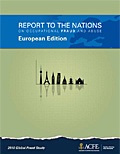A Fraud Report for Europe
/ GUEST BLOGGER
GUEST BLOGGER
Scott Patterson
ACFE Media Relations Specialist
According to ACFE research, the median fraud loss for European organisations is €420,780 – significantly higher than any other world region. In our 2010 Global Fraud Study, European statistics have been presented and analyzed for the first-ever ACFE Report to the Nations on Occupational Fraud and Abuse, European Edition. We’ve published the Report online, as the ACFE European Fraud Conference in Brussels convened Tuesday. As the Wall Street Journal outlined on Tuesday, the European Edition of the Report to the Nations on Occupational Fraud and Abuse focuses exclusively on the 157 cases of occupational fraud from Europe that were included in the study.
 A few of the other interesting findings for Europe include the following:
A few of the other interesting findings for Europe include the following:
- The most common type of occupational fraud is asset misappropriation, which occurred in 78 percent of all cases. Fraudulent financial statements caused the highest median loss in our study (€16,410,420), though there was a small sample of only 10 cases.
- Occupational frauds were much more likely to be detected by a tip than by any other means. We found that 40 percent of all frauds were detected by a tip, while internal audit (17 percent of cases) and management review (16 percent of cases) ranked second and third, respectively.
- Small organisations were disproportionately affected by occupational fraud. The median loss for organisations with fewer than 100 employees was €613,638, while the median loss for organisations with more than 10,000 employees was €231,429.
- The median age of a fraud perpetrator in this study was 43 years old. In addition, perpetrators tended to be male (82 percent of cases), to be managers (50 percent of cases) and to have a university degree or postgraduate degree (55 percent of cases).
- Approximately 82 percent of the perpetrators in this study had never been charged with or convicted of a prior fraud-related offence.
While such figures can seem discouraging in certain ways, they provide important insight for anti-fraud professionals and any business or government leaders in understanding the nature of fraud. Knowing that tips are the leading method of detection, for example, tells us that hotlines are an important part of any fraud prevention strategy.
What do you think are some of the other important conclusions that we can draw from this study?